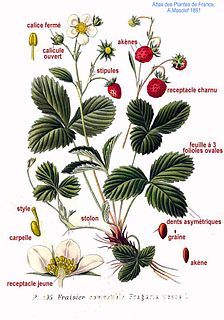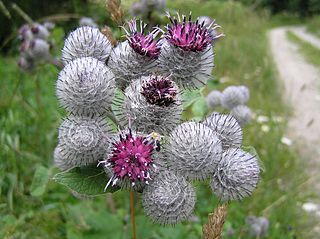Related Research Articles

Pseudotsuga is a genus of evergreen coniferous trees in the family Pinaceae. Common names include Douglas fir, Douglas-fir, Douglas tree, and Oregon pine. Pseudotsuga menziesii is widespread in western North America and is an important source of timber. The number of species has long been debated, but two in western North America and two to four in eastern Asia are commonly acknowledged. Nineteenth-century botanists had problems in classifying Douglas firs, due to the species' similarity to various other conifers better known at the time; they have at times been classified in Pinus, Picea, Abies, Tsuga, and even Sequoia. Because of their distinctive cones, Douglas firs were finally placed in the new genus Pseudotsuga by the French botanist Carrière in 1867. The genus name has also been hyphenated as Pseudo-tsuga.

Fragaria is a genus of flowering plants in the rose family, Rosaceae, commonly known as strawberries for their edible fruits. There are more than 20 described species and many hybrids and cultivars. The most common strawberries grown commercially are cultivars of the garden strawberry, a hybrid known as Fragaria × ananassa. Strawberries have a taste that varies by cultivar, and ranges from quite sweet to rather tart. Strawberries are an important commercial fruit crop, widely grown in all temperate regions of the world.

Bombyx mori, the domestic silk moth, is an insect from the moth family Bombycidae. It is the closest relative of Bombyx mandarina, the wild silk moth. The silkworm is the larva or caterpillar of a silk moth. It is an economically important insect, being a primary producer of silk. A silkworm's preferred food are white mulberry leaves, though they may eat other mulberry species and even the osage orange. Domestic silk moths are closely dependent on humans for reproduction, as a result of millennia of selective breeding. Wild silk moths are different from their domestic cousins as they have not been selectively bred; they are thus not as commercially viable in the production of silk.

Lilium is a genus of herbaceous flowering plants growing from bulbs, all with large prominent flowers. Lilies are a group of flowering plants which are important in culture and literature in much of the world. Most species are native to the temperate northern hemisphere, though their range extends into the northern subtropics. Many other plants have "lily" in their common name but are not related to true lilies.

Arctium is a genus of biennial plants commonly known as burdock, family Asteraceae. Native to Europe and Asia, several species have been widely introduced worldwide.

Morus, a genus of flowering plants in the family Moraceae, consists of diverse species of deciduous trees commonly known as mulberries, growing wild and under cultivation in many temperate world regions. Generally, the plant has three main species ostensibly named for the fruit color of the best-known cultivar: white, red, and black mulberry, with numerous cultivars, but more than 200 species are identified in taxonomy. The name “white mulberry” came about because the first specimens named by European taxonomists were a cultivated mutation prized for their white fruit, but wild trees bear black fruit like other mulberries. White mulberry is native to South Asia, but is widely distributed across Europe, Southern Africa, South America, and North America. It is regarded as an invasive species in Brazil and the United States.

Hornbeams are hardwood trees in the flowering plant genus Carpinus in the birch family Betulaceae. The 30–40 species occur across much of the temperate regions of the Northern Hemisphere.

Urtica is a genus of flowering plants in the family Urticaceae. Many species have stinging hairs and may be called nettles or stinging nettles, although the latter name applies particularly to Urtica dioica.

Mugwort is a common name for several species of aromatic flowering plants in the genus Artemisia. In Europe, mugwort most often refers to the species Artemisia vulgaris, or common mugwort. While other species are sometimes referred to by more specific common names, they may be called simply "mugwort" in many contexts.

Actias is a genus of Saturniid moths, which contains the Asian-American moon moths. Long tails on their hindwings are among their distinctive traits. Other moths with similar appearance are Copiopteryx, Argema and Eudaemonia.

Macrothele is a genus of mygalomorph spiders in the family Macrothelidae, and was first described by A. Ausserer in 1871. It is the only genus in the family Macrothelidae, and most species occur in Asia, from India to Japan, and Java, with four found in Africa, and two in Europe. The name is derived from Ancient Greek μακρός ("makro-"), meaning "big", and θηλή ("thele"), referring to the spinnerets.

Ilex, or holly, is a genus of about 480 species of flowering plants in the family Aquifoliaceae, and the only living genus in that family. The species are evergreen or deciduous trees, shrubs, and climbers from tropics to temperate zones worldwide. The type species is Ilex aquifolium, the common European holly used in Christmas decorations and cards.

Eudonia is a large and widespread genus in the grass moth family (Crambidae), subfamily Scopariinae. There is no common name for the roughly 250 species placed here; new species are still being described regularly. Although the genus was proposed early in the 19th century already, many of these moths were for a long time retained in Scoparia, the type genus of the subfamily and a close relative of Eudonia. A few small genera have been proposed for separation from Eudonia, but given the size of this group this is not particularly convincing; thus, all are retained here pending a comprehensive phylogenetic review.

Autosticha is a genus of gelechioid moths. It belongs to the subfamily Autostichinae, which is either placed in the concealer moth family (Oecophoridae), or in an expanded Autostichidae. It is the type genus of its subfamily. Originally, this genus was named Automola, but this name properly refers to a fly genus in family Richardiidae.
Etielloides is a genus of snout moths. It was described by Shibuya in 1928.
Etielloides bipartitellus is a species of snout moth in the genus Etielloides. It was described by John Henry Leech in 1889, and is known from China, Japan and Korea.
Etielloides curvella is a species of snout moth in the genus Etielloides. It was described by Shibuya in 1928, and is known from Japan.
Etielloides kogii is a species of snout moth in the genus Etielloides. It was described by Hiroshi Yamanaka in 1998 and is known from China and Japan.
Etielloides longipalpus is a species of snout moth in the genus Etielloides. It was described by Ying-Dang Ren and Hou-Hun Li in 2006 and is known from China.

Euzophera cinerosella is a species of snout moth in the genus Euzophera. It was described by Zeller in 1839. It is found in most of Europe, Turkey, Russia and China.
References
- ↑ "GlobIZ search". Global Information System on Pyraloidea. Retrieved August 28, 2017.
- ↑ "A Taxonomic Review of the Genus Etielloides Shibuya (Lepidoptera: Pyralidae: Phycitinae) From China, with Description of a New Species". So.med.wanfangdata.com.cn. doi:10.1179/174591906X95987 . Retrieved 2012-01-17.
- ↑ "Japanese Moths". Jpmoth.org. Retrieved 2012-01-17.
| This Phycitinae-related article is a stub. You can help Wikipedia by expanding it. |